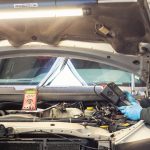Buying Diesel Parts: Price vs. Value
I can admit I love a bargain. Work is hard and I’d rather spend my paycheck on enjoyable things or the future instead of foolhardy purchases. To truly save money in the long run, however, you have to weigh initial price vs. value over the lifetime of whatever it is you buy.
Take this example. A couple of years ago I bought a cordless leaf blower to deal with autumn leaves and general clean up. I chose the generic brand and paid just $75. After using it for just under 2 years, it died and I needed a replacement. This time I went with a respected name brand and paid $225. So, two years, $300 and still just one leaf blower that works. I wish I had shelled out the extra on the first shopping trip and saved that money.
Take a peek at these examples:
NEW TIRES
- TIRE A
- Price per tire: $40
How long will they last? 25,000km$40 / 25,000km = $.0016 for 1km per tire.
- TIRE B
- Price per tire: $80
How long will they last? 50,000km$80 / 50,000km = $.0016 for 1km per tire.
This isn’t difficult math really. The tires cost the same amount, but because one lasts longer, the value seems to be the same. The problem with this table is that other expenses, like mounting and balancing, aren’t taken into account. The tires that last longer will end up costing less when spread out over time.
SET OF 4 NEW TIRES
- TIRE A
- 4 Tires at $40 each = $160
Installation of 4 tires at $60 each = $240Lifetime cost for 25,000km = $.016 per km.
- TIRE B
- 4 Tires at $80 each = $320
Installation of 4 tires at $60 each = $240Lifetime cost for 50,000km = $.0112 per km.
What is this chart telling us?
If you pay a bit more at the start for better quality tires, you end up paying $80 less over 50,000 miles. You will also save the time and energy making another appointment at the tire shop and waiting around for the installation to complete.
BALL JOINTS
- BALL JOINT A
Price per ball joint: $100
How long will they last? 50,000km
- BALL JOINT B
- Price per ball joint: $130
How long will they last? 50,000km
In this example, Ball Joint B has a higher initial price because it includes a lifetime warranty. Instead of paying the whole price each time the ball joint wears out, you will only have to pay the labour charge.
BALL JOINTS FOR LIFE + INSTALLATION
- BALL JOINT A
- $100 per ball joint + $120 installation charge
Cost for 50,000km = $220 charge each time
- BALL JOINT B
- $130 per ball joint + $120 installation charge once
Cost for 50,000km = $250 the first time, but only $120 for all future replacements.
The total amount you save in this scenario really depends on how long the truck lasts. Over the lifetime of a truck that lasts for 150,000km, your savings will be around $170 if you buy the more expensive ball joint in the first place. Not a bad bonus for investing a bit more in your vehicle from the start.
The same price vs. value comparison pertains to fuel injection systems as well.
INJECTORS – SPOOL VALVES
Unlike other companies that re-use spool valves, we always use perfectly new ones in our 6.0 injectors. Over time, a spool valve will wear down and a greater volume of oil will bypass it. All of that oil is supposed to be creating proper pressure when the engine is operating under a full load. If too much sneaks out, the engine will not function as well as it should.
Is the difference between our NW Fuel Injector and a competitor’s brand obvious and immediate? Not really. But as the examples above demonstrate clearly, immediate savings does not equal good value. Our injectors last a lot longer and provide continuous full power for years. Theirs’ simply won’t. Cutting costs and corners by using worn spool valves that barely meet minimum requirements means NOT meeting those requirements really soon. The result? Your vehicle loses power, can’t handle the loads it should, and you have to hand over even more money to replace the injector a lot sooner than you would if you had opted for one with new spool valves from the start.
INJECTORS – BOSCH COMMON RAIL
In a recent test conducted by Bosch, more than 50% of non-OEM rebuilt injectors failed.
All 2008 and later engines have particulate filters that get rid of or reduce visible exhaust smoke. This may hide the symptoms of a fuel injector problem for quite some time. This can lead to misdiagnosis and unhappy customers who still complain of low fuel economy and lack of overall power.



